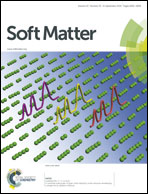A spontaneous penetration mechanism of patterned nanoparticles across a biomembrane†
Abstract
Recent experimental studies have shown the ability of tailoring the nanoparticle (NP)–cell interaction via the engineering of NP surfaces. Although the considerable progress has been made in design of patterned NPs for drug delivery, the effect of surface pattern on the NP–cell interaction is not fully understood yet. In this work, we used a dissipative particle dynamics method to systematically investigate the effects of NP surface pattern on its penetration across a membrane. For stripy NPs or patchy NPs having a large stripe width or patch size, an “insertion–rotation” penetration mechanism is found. Results indicate that stripy NPs and patchy NPs coated with narrow stripes or small patches can directly penetrate the cell membrane with a less constrained rotation. By considering the spontaneous penetration of many NPs into a vesicle, we found that NP aggregation would lead to the shape change of the vesicle, and therefore cause the leakage of encapsulated solvent or membrane rupture, implying the possible cytotoxicity. In short, this work gives a fundamental understanding for the penetration mechanism of the ligand patterned NPs, which provides useful reference for the design of NPs for controllable cell penetrability and targeted delivery of drugs.


 Please wait while we load your content...
Please wait while we load your content...